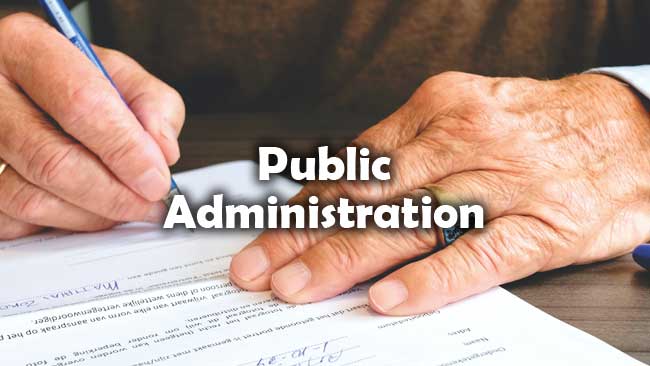Public Administration Quiz
Public Administration Quiz question paper pdf for examination is given below. This helps in analyzing Public Administration question and answers. Public Administration exam Quiz question papers direct download links are given in this section.

Hence, download the Public Administration Quiz Paper pdf below. Public Administration Quiz Papers Pdf help the applicants in their preparation.
Quiz Question Papers on Public Administration
1. Content analysis, as a qualitative technique, aims at :
(A) Objective information
(B) Subjective information
(C) Time frequency
(D) Duration of event
2. The population that provides the basis for sampling is known as :
(A) Sample
(B) Sampling frame
(C) Target population
(D) Sampling unit
3. The Central Welfare Board was founded in which year ?
(A) 1950
(B) 1953
(C) 1956
(D) 1959
4. The child development centres mainly concern with :
(A) Education
(B) Vocational training
(C) Malnutrition
(D) Scholarships
5. Which of the following is not a Public Undertaking ?
(A) BHEL
(B) SAIL
(C) GAIL
(D) TISCO
6. The priority sector under Industrial Policy 1991 was :
(A) Agriculture
(B) Industry
(C) Essential infrastructure
(D) Export
7. ‘‘Commanding heights of economy’’ resulted in :
(A) More Government Control over PSUs
(B) Creation of more ‘Navratna’ companies
(C) Merger of private companies in public sector
(D) Expansion of Public Sector
8. In which country the consideration of expenditures and tax measures is not coordinated ?
(A) USA
(B) UK
(C) India
(D) France
9. ‘Magna Carta’ of Local Self Government is related to :
(A) Lord Mayo’s Resolution
(B) Lord Ripon’s Resolution
(C) Royal Commission
(D) Diarchial Scheme
10. The 64th Constitutional Amendment Bill in Lok Sabha in 1989 was in response to recommendation of :
(A) G.V.K. Rao Committee
(B) Ashok Mehta Committee
(C) L.M. Singhavi Committee
(D) K. Santhanam Committee
11. Reservation of women at Panchayat Level ensures mainly :
(A) Economic Welfare
(B) Gender Equality
(C) Participation in Public Life
(D) Social empowerment
12. Which committee recommended the Mandal system ?
(A) Ashok Mehta Committee
(B) Balwant Ray Mehta Committee
(C) Singhavi Committee
(D) ARC
13. ‘Towards A New Public Administration : A Minnowbrook Perspective’ was edited by :
(A) Frank Marini
(B) Dwight Waldo
(C) John C. Honey
(D) James C. Charlesworth
14. ‘Reinventing Government’ was written by :
(A) Campbell and Allen
(B) Christenson and Brown
(C) Garron and Overman
(D) Osborne and Gaebler
15. In its approach Aarthshastra is :
(A) Idealistic
(B) Philosophical
(C) Prescriptive
(D) Empirical
16. Herbert Simon’s concept of administration is based on :
(A) Structural-functional approach
(B) Systems approach
(C) Logical positivism
(D) Elite approach
17. ‘Human Relationists’ are criticized as :
(1) Happiness boys
(2) Cow psychologist
(3) New Right philosophist
(4) Organisational elitist
Codes :
(A) (2) and (3)
(B) (1), (2) and (4)
(C) (1) and (2)
(D) (1), (2), (3) and (4)
18. Who advocated the theory of domination ?
(A) Herbert Simon
(B) Max Weber
(C) Chester Barnard
(D) Chris Argyris
19. Public choice approach emphasizes on :
(A) Separation of administration and politics
(B) Neutral Bureaucracy
(C) Diverse democratic decisionmaking centres
(D) Hierarchical monocentric administration
20. Riggs describes ‘Office’ in a Fused Society as :
(A) Canteen
(B) Chamber
(C) Clects
(D) Bureau
| GK | Old Question |
| MCQ | Previous Question |
| Quiz | UGC NET |
| Sample Question | IGNOU MPA |
| Model Papers | UPSC |
21. According to F.W. Riggs, the trend in comparative public administration is :
(1) Normative to empirical
(2) Ideographic to nomothetic
(3) Empirical to normative
(4) Non-ecological to ecological
Select the correct code :
(A) (1), (2) and (4)
(B) (1), (2) and (3)
(C) (2), (3) and (4)
(D) (1) and (3)
22. To critics, Riggs “Prismatic and Sala Model” is :
(A) Equilibrium model
(B) Rational model
(C) Ideal model
(D) Empirical model
23. Bureaucratic typology by Ferrel Heady is :
(1) Benevolent Autocratic
(2) Bureaucratic Elite
(3) Polyarchial Competitive
(4) Dominant Party Mobilization
Codes :
(A) (2), (3) and (4)
(B) (1) and (2)
(C) (1), (2) and (3)
(D) (3) and (4)
24. Assertion (A) Reason (R) :
Assertion (A) : France is more unitary than Britain
Reason (R) : In Britain, local government enjoys a certain degree of autonomy
Answer the question by using the codes given below :
Codes :
(A) Both (A) and (R) are true and (R) is the correct explanation of (A)
(B) Both (A) and (R) are true but (R) is not the correct explanation of (A)
(C) (A) is true but (R) is false
(D) (A) is false but (R) is true
25. The following mechanism was created in Britain to examine the complaints of maladministration :
(A) Ombudsman
(B) Whitley Council
(C) Parliamentary Commissioner
(D) Procurator-General
26. Atkinson Commission has recommended classification of civil services as :
(1) Imperial services
(2) Provincial services
(3) Local services
(4) Subordinate services
Select the correct answer from the codes given below :
Codes :
(A) (1) and (2)
(B) (1), (2) and (3)
(C) (1), (2) and (4)
(D) (2), (3) and (4)
27. According to Fred Riggs development administration is :
(A) A process leading to increasing ability to make collective decisions
(B) Implementation of programmes towards modernity
(C) Carrying out planned changes
(D) Mechanism of alleviating poverty
28. Bureaucratie developments in democratic countries are considered to be :
(A) Positive
(B) Welfare-oriented
(C) Antithesis
(D) Democratic
29. The terms ‘eo’, ‘ortho’ and ‘neo’ are related to :
(A) Fused society
(B) Prismatic society
(C) Diffracted society
(D) SALA model
30. The condition for a country to become a member of World Bank :
(A) It must be a developing country
(B) It must have sound financial condition
(C) It must join International Monetary Fund
(D) It should have healthy political environment
31. Project means :
(1) A standard operating procedure
(2) A standard planning procedure
(3) A logical method of performing work
(4) Forecasting of public affair
Select the correct answer from the codes given below :
Codes :
(A) (1) and (2)
(B) (1) and (3)
(C) (2) and (3)
(D) (2) and (4)
32. Which of the following was replaced by General Agreement on Trade and Tarriff (GATT) in 1995 ?
(A) International Monetary Fund
(B) International Finance Corporation
(C) World Trade Organisation
(D) International Bank for Reconstruction and Development
33. Public sector undertakings differ from private sector undertakings mainly in :
(A) Resource Mobilization
(B) Technology inputs
(C) Organizational processes
(D) External Accountability
34. “A small body of serious thinkers have turned into a government department” has been said for :
(A) Union Public Service Commission
(B) Finance Commission
(C) Planning Commission
(D) National Development Council
35. Indian Civil Services are :
(1) Governmental Mechanism
(2) Non-military by nature
(3) Body Corporate by structure
(4) Accountable to people
Select the correct answer from the codes given below :
Codes :
(A) (1) and (3)
(B) (1) and (2)
(C) (1), (2) and (3)
(D) (1), 2), (3) and (4)
36. Central Administration in India is characterised by :
(A) Continuity of Administrative Leadership
(B) Stability of Political Leadership
(C) Accountability to Parliament
(D) Financial Autonomy
37. Which of the following training institutes provides in-service training to IAS officers ?
(A) National Institute of Rural Development, Hyderabad
(B) Indian Institute of Public Administration, New Delhi
(C) Indian Institute of Management, Ahmadabad
(D) National Academy of Administration, Mussoorie
38. District Collector is a Chief Executive Officer of Zila Parishad in :
(A) Rajasthan
(B) Andhra Pradesh
(C) Odisha (Orissa)
(D) Kerala
39. Audit by Comptroller and Auditor General (CAG) is concerned with :
(A) Administrative Audit
(B) Financial Audit
(C) Social Audit
(D) People’s Audit
40. The emphasis of Mayo Resolution (1870) was on :
(A) Administrative needs
(B) Popular pressure
(C) Financial Sharing
(D) Experiments in local administration
41. ‘Citizen’s Charter’ guarantees …………………. in administration.
(A) Transparency
(B) Flexibility
(C) Neutrality
(D) Quality Approach
42. Lokayukta has power to investigate cases of both the grievances and allegations of Maladministration in :
(A) Rajasthan
(B) Maharashtra
(C) Gujarat
(D) Madhya Pradesh
43. The Report on “Right to Information” submitted by second Administrative Reforms Commission (ARC) is known as :
(A) Master key to Good Governance
(B) The heart of Governance
(C) From despair to hope
(D) An inspiring journey into future
44. The most important factor in theoretical research is :
(A) Concept
(B) Hypothesis
(C) Research Design
(D) Correlational Analysis
45. Research that is concerned with testing cause and effect relationship is :
(A) Pure Research
(B) Exploratory Research
(C) Explanatory Research
(D) Applied Research
46. Closed ended questions :
(A) Have a fixed range of possible answers
(B) Prevent respondents from categorisation
(C) Encourage detailed responses
(D) Relate to the basic demographic characteristics of respondents
47. Arithmetic mean is used in :
(A) Qualitative Analysis
(B) Orderly Ranking of Units
(C) Calculating Ratio
(D) Comparative purposes
48. American Psychological Association (APA) style is related with :
(A) Research Tabulation Style
(B) Research Referencing Style
(C) Report Writing Style
(D) Data Collection System
49. The following is an art of implementing welfare policies into action :
(A) Development Administration
(B) New Public Management
(C) Social Administration
(D) New Public Administration
50. Accountability of public enterprises in nature is always :
(A) Active
(B) Positive
(C) Purposive
(D) Post facto

